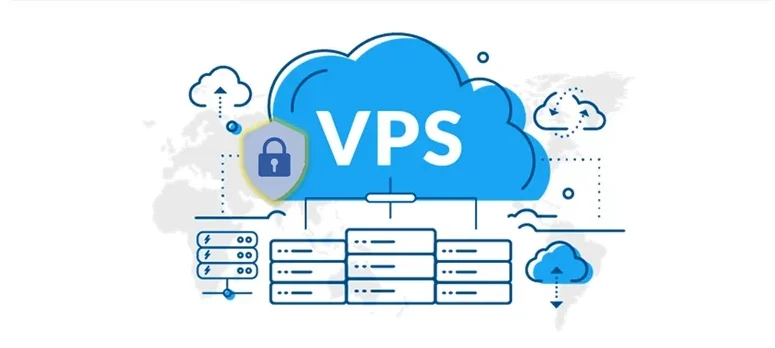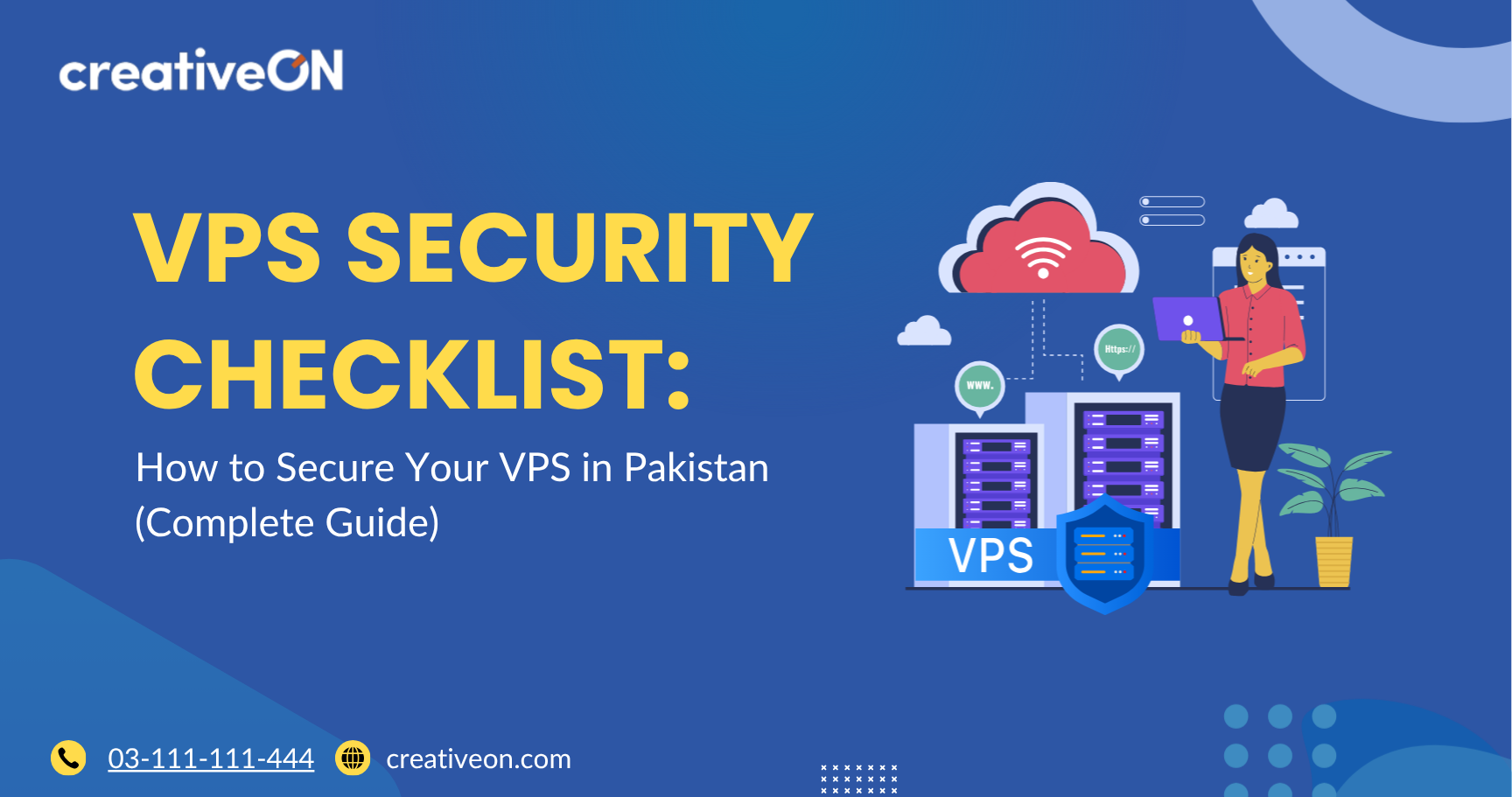Hey there! 👋 Running your own VPS (Virtual Private Server) in Pakistan is exciting — it gives you more control, flexibility, and power than shared hosting. But before you celebrate, there’s one thing you absolutely must take seriously: VPS security.
Think of your VPS like your home on the internet. You wouldn’t leave your front door unlocked in a busy neighborhood, right? The same goes for your server. Without proper security, hackers can break in, steal your data, and damage your business.
At CreativeON, we’ve been securing VPS servers in Pakistan for over 20 years. We’ve seen every kind of attack — from brute-force password attempts to sneaky malware injections. The good news? Most of these threats can be stopped with simple, practical steps.
Let’s go through your complete VPS Security Checklist so you can lock down your server like a pro.

Why VPS Security in Pakistan Matters
When you host websites, apps, or emails on a VPS, you’re in charge of your own environment — and that means your own protection. If you ignore security, you risk losing your customers’ trust, your business data, and even your Google rankings.
At CreativeON, Pakistan’s trusted VPS hosting provider and Google Workspace Partner, we help clients like City42, Chughtai Lab, and Orange Line Metro stay safe online. Here’s how you can do it too.
✅ Your VPS Security Checklist: 16 Must-Do Steps
1. Choose a Secure VPS Provider (Like CreativeON!)
Start with a reliable, security-focused VPS hosting provider. CreativeON VPS Hosting in Pakistan includes:
- DDoS protection against fake traffic attacks
- Automatic malware scanning with Monarx
- Regular offsite backups
- 24/7 server monitoring by experts
💡 Bonus: Because we’re a Google Partner, our VPS prices stay low while maintaining top-tier performance and security.
2. Change Your SSH Port (Stop the Bad Guys Early)
Hackers love scanning servers with the default SSH port (22). Changing it makes brute-force attacks much harder.
👉 Example: use something like 2421 or 2207 instead of 22.
It’s a simple fix that hides your “front door” from automated bots.
3. Disable Root Login (Don’t Give Away the Master Key)
Root access is powerful — too powerful. Disable direct root login and create a new user with admin (sudo) privileges.
That way, even if someone guesses your password, they can’t instantly take over your VPS.
4. Use Strong Passwords (Make Them Impossible to Guess)
Weak passwords are still the #1 reason servers get hacked.
✅ Tips for strong passwords:
- Minimum 12 characters
- Use upper/lowercase letters, numbers, and symbols
- Avoid personal info (no birthdays or pet names)
- Use a password manager like Bitwarden or 1Password
5. Set Up SSH Keys (Your VIP Access Pass)
SSH keys are a safer way to log into your VPS without using passwords. They’re almost impossible to brute-force.
When configured correctly, only your unique private key can connect to your server — a must for serious VPS users.
6. Install a Firewall (Your Server’s Security Guard)
A firewall filters incoming and outgoing traffic — only trusted connections get through.
Popular Linux firewall tools:
- UFW (Uncomplicated Firewall)
- iptables
At CreativeON, our VPS hosting comes pre-configured with essential firewall rules to keep your system safe.
7. Use SFTP Instead of FTP (Encrypt Your Transfers)
FTP sends data in plain text — anyone can read it. Switch to SFTP, which encrypts everything you upload or download from your VPS.
It’s like sending sealed envelopes instead of postcards.
8. Install Fail2Ban (Your Automatic Bouncer)
Fail2Ban automatically blocks IPs that repeatedly fail login attempts. It’s a smart way to prevent brute-force attacks 24/7.
Once installed, it quietly runs in the background and keeps bad actors out.
9. Keep Your Software Updated (Patch Those Holes!)
Old software is the hacker’s best friend. Regular updates fix security holes before they’re exploited.
Set your system to auto-update or at least schedule weekly manual updates for OS, CMS (like WordPress), and installed apps.
10. Install Antivirus Software (Your Digital Immune System)
Linux VPS users often skip antivirus, but that’s risky. Tools like ClamAV can scan and quarantine suspicious files.
Ensure your VPS has at least 2GB RAM to run antivirus smoothly.
11. Use a Malware Scanner (Catch the Sneaky Stuff)
Antivirus tools detect known threats, but malware scanners catch emerging ones.
All CreativeON VPS Hosting plans include Monarx Malware Scanner — it runs automatically to detect and remove malicious scripts.
12. Set Up a VPN (Stay Hidden from Hackers)
If you manage your VPS from public Wi-Fi or open networks, use a VPN. It encrypts your connection and hides your location — keeping your logins safe from prying eyes.
13. Manage User Permissions (Control Who Gets Access)
Not everyone should have admin rights. Create specific user accounts with limited permissions.
Think of it like giving someone a key to the living room, not your entire house.
14. Disable IPv6 (If You Don’t Need It)
IPv6 can open unnecessary attack vectors if not configured. Disable it unless your applications specifically require it.
15. Monitor Your Server Logs (Stay Alert)
Logs tell the story of what’s happening on your server. Check them regularly for strange login attempts, unknown IPs, or unauthorized changes.
Pro tip: use log monitoring tools or configure alerts to catch problems early.
16. Regular Backups (Your Safety Net)
Even with the best security, accidents happen. Backups are your last line of defense.
Best practices:
- Enable daily automatic backups
- Store them offsite (e.g., Google Cloud or another CreativeON data center)
- Test restore points monthly
⚔️ Common VPS Security Threats in Pakistan
- Brute-force attacks: Thousands of password attempts per minute
- DDoS attacks: Flooding your server with fake traffic
- Malware infections: Stealing data or hijacking resources
- SQL injection: Exploiting insecure database inputs
- Phishing scams: Fake emails stealing your credentials
At CreativeON, we build VPS solutions that protect you from all of these — before they even start.
🌐 Why Choose CreativeON for VPS Security in Pakistan
We’re not just another hosting provider — we’re Pakistan’s leading VPS hosting company and an official Google Workspace Partner.
What sets us apart:
- PKNIC Gold Partner for .PK domains
- Trusted by major Pakistani brands
- 24/7 expert support team
- Built-in DDoS protection, malware scanning, and backups
- Affordable VPS prices (we cut our profit margins to give you the best value!)
Check our full range of secure VPS plans here:
👉 CreativeON VPS Hosting in Pakistan
🧠 Frequently Asked Questions (FAQ)
Start by changing your SSH port, setting up a firewall, and disabling root login. These three steps block 80% of common attacks.
Set up automatic updates or do manual updates weekly. Keeping your OS and software up-to-date prevents most vulnerabilities.
Both can be secure if configured properly, but Linux has fewer active malware threats.
Look for slow performance, high CPU usage, new unknown files, or suspicious IPs in logs.
Yes! Our managed VPS plans include 24/7 monitoring, malware protection, and security patching — all handled by our experts.
Getting Started with VPS Security
Security doesn’t have to be overwhelming. Take it step-by-step:
Week 1: Change passwords, disable root login, change SSH port
Week 2: Set up firewall, enable auto-updates
Week 3: Install antivirus and malware scanners
Week 4: Set up regular backups and review logs
Remember — VPS security isn’t a one-time setup, it’s an ongoing process. But with these steps (and a reliable partner like CreativeON), you’re already far ahead of most users.
🔒 Ready to Secure Your VPS in Pakistan?
At CreativeON, we make VPS hosting secure, simple, and affordable. Whether you’re setting up your first VPS or managing multiple servers, our team is here to help you every step of the way.
👉 Get Your Secure VPS in Pakistan Today

The author
Asher Feroze
I’m Asher Feroze, and I’ve been part of CreativeON for several years, working in various roles including Manager Operations, Business Development Manager, and technical support for our web hosting services. Over time, I’ve gained deep insights into both the business and technical sides of the industry. Now, I use that experience to write informative articles for CreativeON, Gworkspace, and gworkspacepartner.pk, helping readers make smart choices when it comes to web hosting and Google Workspace solutions.

